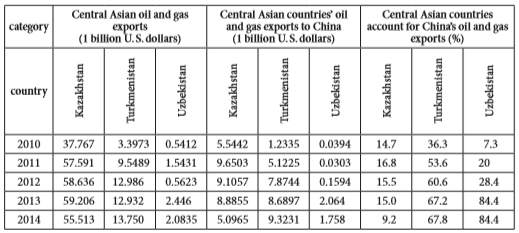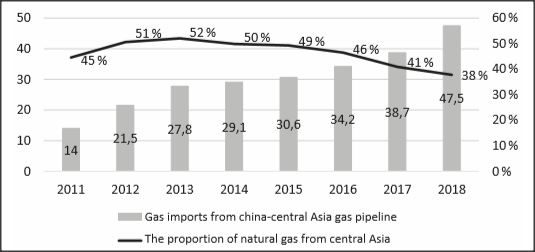Table 2. The Dependence of Oil and Gas Resources Exports from Central Asian Countries on China

Source: United Nations Conference on Trade and Development (UNCTAD) database.
Secondly, pipeline transportation cooperation has made breakthrough progress. The China-Kazakhstan oil pipeline is an important symbol of the construction of Eurasian oil and gas pipeline network of the 21st century. In order to ensure the safety and development of oil and gas resources trade between China and Central Asian countries, in July 2004, China and Kazakhstan began to build China-Kazakhstan oil pipeline with a total length of more than 2,800 kilometers and an annual designed oil transportation capacity of 20 million tons. The first phase of the project was completed in 2006, and the second phase in 2009. This pipeline has become one of the most important transnational oil pipelines in China. By the end of 2015, China-Kazakhstan oil pipeline has delivered a total of 87.24 million tons of crude oil to China, with an annual oil output of more than 10 million tons. In August 2007, China, Turkmenistan, Kazakhstan and Uzbekistan began the joint construction of China- Central Asia gas pipeline. The pipeline is about 10,000 kilometers, which connects from west to east Turkmenistan, Uzbekistan, Tajikistan and Kyrgyzstan and China. Central Asia gas pipeline has 4 lines (A, B, C, and D). Line A, Line B and Line C were put into operation respectively in 2009, 2010 and 2014. From 2011 to the end of 2017, Line A, Line B and Line C imported a total of 195.9 billion cubic meters of natural gas. Natural gas imports in 2018 are expected to amount to nearly 50 billion cubic meters. In recent years, natural gas imported from Central Asian countries accounted for 52 % of the total share of China’s total imports (see Figure 1).

Figure 1. Volume and Proportion of Imported Natural Gas from “China-Central Asia Natural Gas Pipeline” Source: The author draws it according to the Customs data of the People’s Republic of China.
Thirdly, cooperation of petroleum refining and petrochemical industries continues to promote and provide a powerful boost for the modernization of Central Asian countries’ energy industry. Since the proposal of “Belt and Road” initiative in 2013, energy cooperation has become the pioneering industry and an important engine for the “Belt and Road” construction. Since the cooperation in the energy industry has saturated, the downward extension of industrial chain cooperation has become an important development direction for energy industry cooperation between China and Central Asian countries. The refining and petrochemical projects carried out by China and Central Asian countries in recent years can be seen in Table 3.
Table 3. China’s Major Cooperation Projects in the Refining and Petrochemical Industries in Central Asia.

Source: Ministry of Commerce of China.
The fourth is to provide development assistance to Central Asian countries to help them ease urgent economic and humanitarian difficulties. Kyrgyzstan, Tajikistan and Uzbekistan are the main targets of China’s official development assistance. China’s official development assistance to Uzbekistan accounts for more than half of China’s total aid to Central Asia. Kyrgyzstan and Tajikistan together account for about 40 % of China’s official development assistance to Central Asia. In a certain period of time in the future, China will become the largest official development aid country of Central Asia. China’s official development assistance is mainly invested in the transportation and energy sectors. Unlike European countries, the United States, Japan and other donor countries, official development assistance provided by China only supports specific projects and does not impose political conditions. The purpose of China’s aid is not to use aid to impose policy or other decision-making influence on aid recipients, but to hope to carry out some projects with significant impact.









